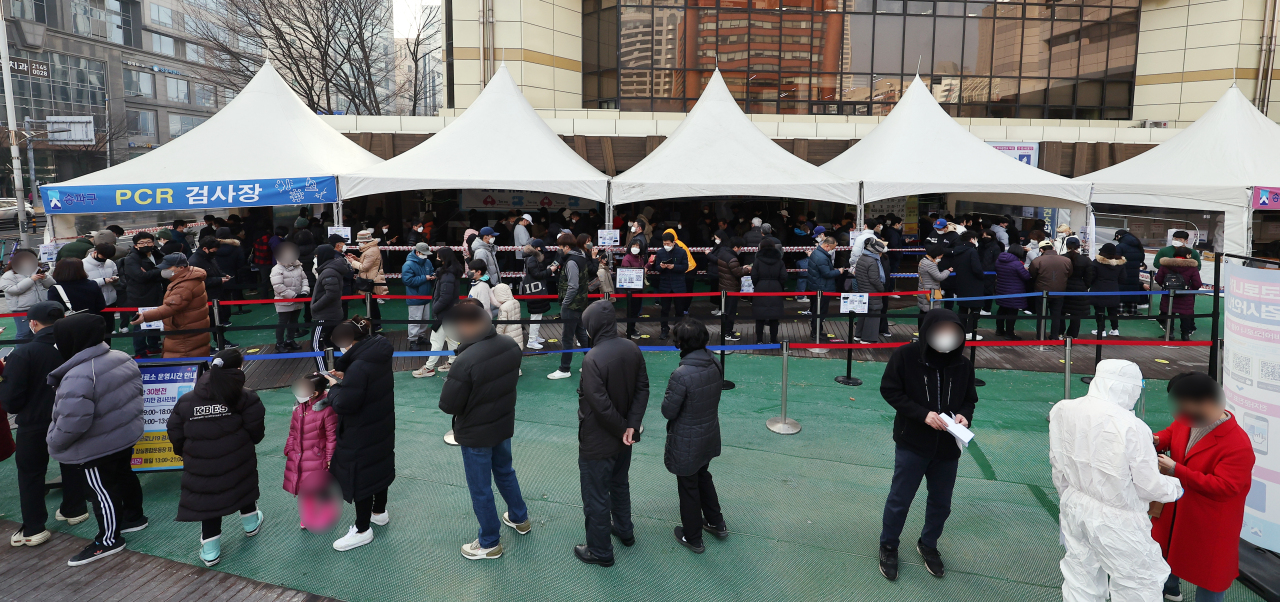 |
Citizens wait in line to receive COVID-19 tests at a state-run medical center in eastern Seoul on Wednesday, when South Korea reported a record high of 342,446 new COVID-19 infections. (Yonhap) |
South Korea's daily COVID-19 cases soared to hit a fresh record high of more than 340,000 Wednesday while voters went to the polls to pick a new president amid the fast spread of the omicron variant.
The country reported 342,446 new COVID-19 infections, including 342,388 local cases, raising the total caseload to 5,212,118, according to the Korea Disease Control and Prevention Agency (KDCA).
The tally jumped from the 202,721 reported Tuesday.
Daily infections exceeded the 300,000 mark for the first time just a week after topping 200,000 on March 2. The previous record high was the 266,847 reported Friday.
The accumulated virus cases also surpassed 5 million about 780 days after the first case was reported in January 2020. This means one-tenth of the country's 52 million population has been infected with the virus.
The surge in virus cases raised the number of COVID-19 deaths and critically ill patients.
The country added 158 more COVID-19 deaths, raising the total deaths to 9,440, according to the KDCA. The fatality rate was 0.18 percent.
The number of seriously ill virus patients came to 1,087, up from the previous day's 1,007. The tally's record high was 1,151 cases on Dec. 29. The government forecast the number of critically ill COVID-19 patients to swell to 1,700 to 2,750 by the end of March.
Health authorities earlier forecast the current omicron wave may peak at some 354,000 on March 12. But given the current trend, the virus appears to be spreading at a faster pace.
Experts said after daily infections reach around 250,000-350,000 within one or two weeks, they are expected to slowly fall.
Citing cases of other nations, they said the daily count will likely enter the downward trend only after the accumulated number of virus patients reaches 10 million, equivalent to 20 percent of the total population.
South Koreans are voting Wednesday to pick a new president in the midst of the upsurge in COVID-19 cases.
Virus patients and those in quarantine are allowed to vote from 6 p.m. to 7:30 p.m. after regular voting closes.
The state election watchdog has decided to permit them to directly put their votes into ballot boxes, as the collection of their votes in unofficial containers during last week's early voting sparked complaints of foul play.
On Monday, the KDCA raised the country's risk level of the pandemic to the highest for the week ending Saturday amid the fast spread of the highly contagious omicron variant.
Facing a shortage of medical resources, the government turned its focus to treating serious cases and preventing deaths, ending its rigorous contact tracing program.
It also increased the use of rapid antigen self-test kits and at-home treatment to prevent hospitals from being overwhelmed with COVID-19 patients.
Despite the spike in virus cases, the government relaxed part of its antivirus curbs to reduce financial pain for small businesses. Cafes and restaurants have been allowed to run until 11 p.m. since Saturday, while the government maintained the cap of private gatherings at six people.
Of the locally transmitted cases reported, Seoul reported 74,222 new cases. The surrounding Gyeonggi Province and the western city of Incheon added 96,681 and 18,823 new infections, respectively. Cases from overseas went up 158 to 29,964.
The number of patients receiving at-home treatment hit another high of 1.22 million, up 54,834 from the previous day.
As of the midnight, 31.9 million people, or 62.2 percent of the country's 52 million population, had received booster shots. The number of fully vaccinated people came to 44.4 million, accounting for 86.5 percent, according to the KDCA. (Yonhap)





![[Exclusive] Hyundai Mobis eyes closer ties with BYD](http://res.heraldm.com/phpwas/restmb_idxmake.php?idx=644&simg=/content/image/2024/11/25/20241125050044_0.jpg)

![[Herald Review] 'Gangnam B-Side' combines social realism with masterful suspense, performance](http://res.heraldm.com/phpwas/restmb_idxmake.php?idx=644&simg=/content/image/2024/11/25/20241125050072_0.jpg)
